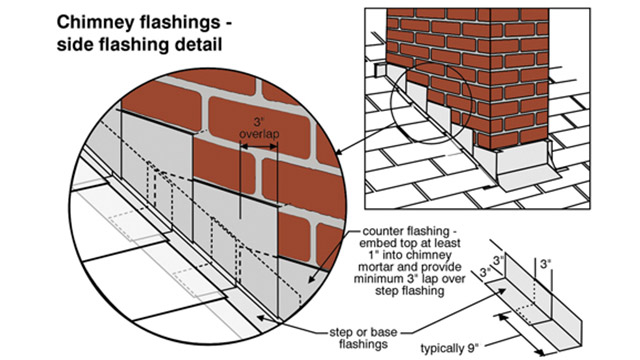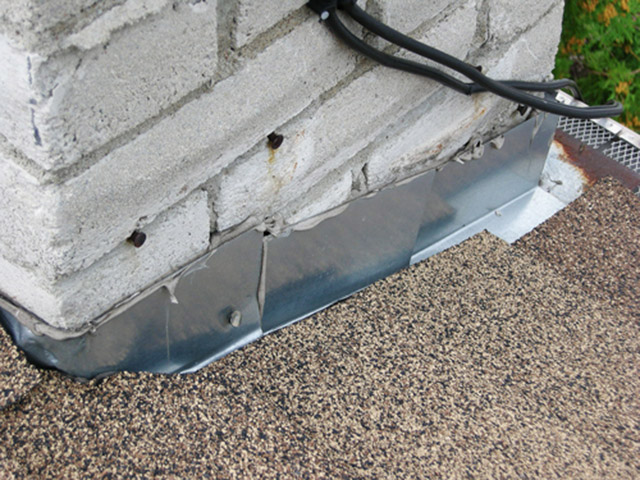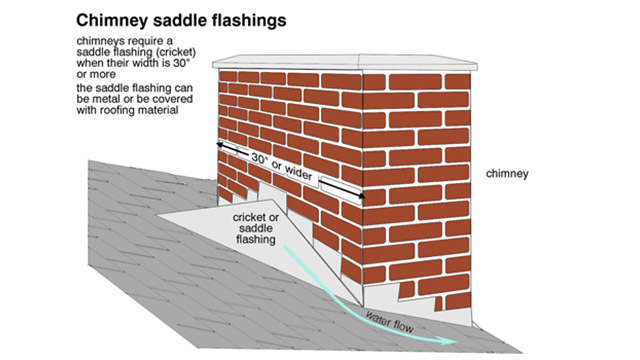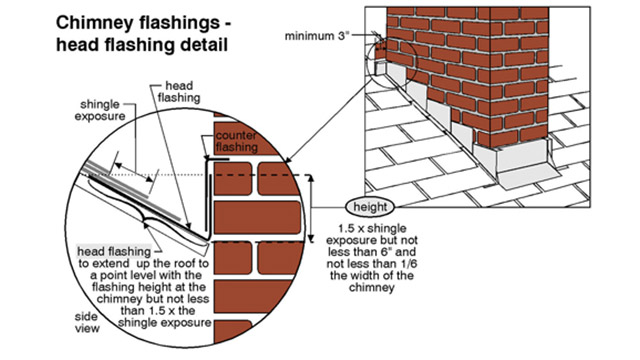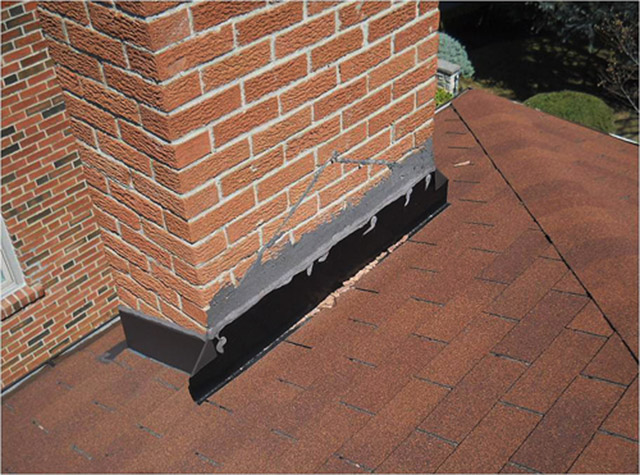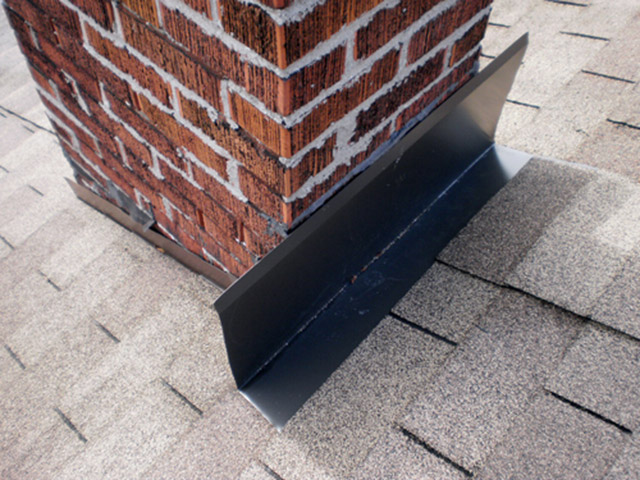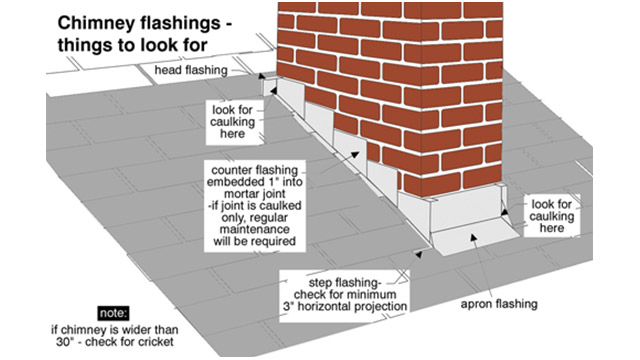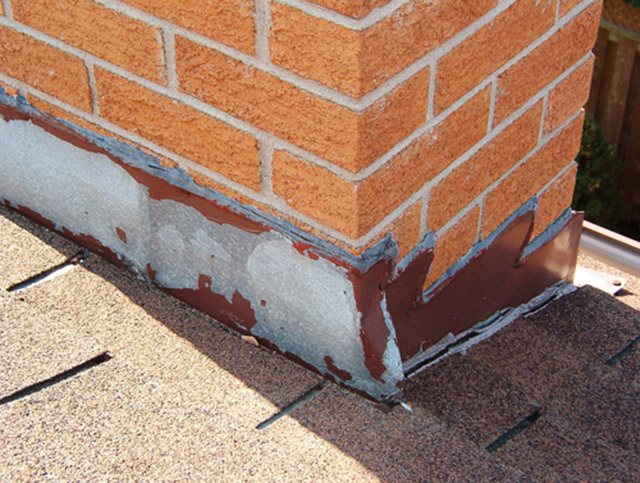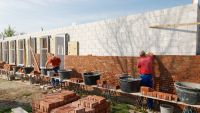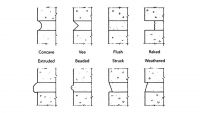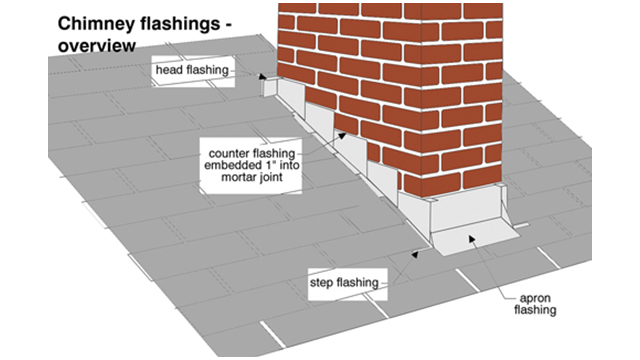
Chimney flashings
Masonry chimneys
Typically, chimney flashings are more complex than other types of roof flashings and are a common source of roof leaks. As a rule, chimneys are either masonry or metal. Some chimneys are clad in wood, stucco or aluminum siding. Round metal chimneys will be flashed much like pipes. Let's focus on masonry chimneys since they are the most challenging and one of the most common.
Allowing for movement
Chimneys have a foundation, which may be independent from the house. In any case, the roof deck may move relative to the masonry chimney and good flashing details anticipate this. Good chimney flashings are two-part. The base flashings are secured to the deck and the cap flashing is secured to the masonry. The overlap between these two flashings allows movement without disturbing the watertightness.Typical materials
Chimney flashings typically are made of one of the following:- galvanized steel
- galvalume
- lead
- copper
- lead-coated copper
On a chimney, flashing is required at the bottom, the sides and the top.
Each of these ideally would have a base (step if it's on the sides) flashing and a cap (counter) flashing; however, bottom flashings and top flashings (where there is no saddle) often are one piece.
Let's look at how chimney flashings are installed.
Base flashing
Bottom: Before the base flashing is installed, the roof is shingled up to the bottom of the chimney. The bottom base flashing is made of a single piece of metal extending 3 to 6 inches down over the shingles that already have been installed, and 12 inches (some say less) up the bottom face of the chimney. This flashing wraps a few inches around the sides of the chimney.Sides: The base flashing for the sides of the chimney is called a step flashing. Others call these soakers or baby tins. The step flashings typically are 3 inches wide, 3 inches tall (some recommend wider and taller, as much as 6 inches in each dimension) and about 9 inches long. They typically are the length of the shingle exposure, plus 3 inches (some say 2 inches!). These base flashings are nailed to the deck.
Cricket or saddle
A cricket or saddle is typical on a chimney and is required by many authorities when the chimney width is more than 30 inches. The cricket or saddle is a peak that deflects water and snow around the chimney, preventing it from accumulating against the top side of the chimney. The cricket usually is made of the same material as the roof sheathing (plywood or waferboard in modern construction). Where no cricket is used, the top flashing should extend at least one-sixth of the chimney's width up the chimney (6 inches minimum) and should extend up the roof under the shingles to a height that is equal to the distance the other end of the flashing extends up the chimney (some say 18 inches).All of the base flashings are fitted against, but not attached to the masonry.
Counter (cap) flashings
Bottom: The bottom cap flashing (or counter flashing) is a single piece of metal that covers the vertical portion of the base flashing. Cap flashings should be fastened to the chimney only. In good quality work, the top is bent and set 1 to 11⁄2 inches into a mortar joint (reglet). This mortar joint is sealed with mortar (and sometimes a flexible caulking). The bottom of the flashing is open and does not extend down to the roof surface. In higher quality work, the bottom 1⁄2 or 3⁄4 inch is turned under 180° to provide a stronger, smoother edge (sometimes called a hem).Just as the bottom base flashing did, the bottom cap flashing wraps around the sides of the chimney.
Sides: The side cap flashings (or counter flashings) usually are several pieces of metal that overlap the step (base) flashings. Again, the cap flashings don't extend down to the roof surface. The top edge of the cap flashings is bent and set into mortar joints. Adjacent cap flashings overlap the lower cap flashings at least 3 inches horizontally as you move up the side of the chimney. Often, the vertical exposed face of the cap flashing is cut back on an angle to create a Z-look to the flashing.
Top: The top cap flashings are installed essentially the same way as the side cap flashings.
As you can see, flashing chimneys properly is a complex job. Do people ever cut corners? Sure they do. We've talked about how it's supposed to be done properly. A high-quality installation is rare. Let's look at what we usually find.
Conditions
When looking at a masonry chimney, we're going to be looking for the following conditions:- rust
- damage (including loose flashings or flashings that are opened at the top)
- installation-related problems
Damaged flashings are a result of animal damage, differential movement of the roof and chimney, mortar or fastener deterioration and careless roofing or masonry work nearby.
Installation problems are, of course, workmanship issues. Leakage is the implication here. Not only can interior and structural damage take place, but also the masonry can be damaged over time.
The first thing to check for on chimney flashings is to make sure all the required pieces are there. The second thing is to check the top of the cap flashing. In many cases, the tops are not set properly into mortar joints. You should consider any caulked joint at the top of the cap flashing, or a joint that employs asphalt cement, as a temporary situation. Let your client know that this will be an ongoing maintenance issue.
Lift the shingles carefully to check the horizontal projection of the side base flashings. Make sure the bottom cap flashing extends down at least 4 inches onto the shingles.
Make sure there is a cricket if the chimney is 30 inches wide or more. If the chimney is narrow (less than 30 inches wide) and there is no cricket, make sure that the cap flashing on the top side of the chimney extends high enough up the chimney and up the roof.
As with all roofing-related inspections, you aren't finished until you've checked the area below the chimney flashing for evidence of leakage inside the building or in the attic area.
About the Author
The ASHI@Home education system is a comprehensive distance-learning program developed with ASHI by one of the most respected names in training and professional home inspection — Carson Dunlop. This program goes far beyond an introduction to home inspection, providing career training that prepares you for success in this exciting consulting profession. Also, individual modules are approved for ASHI CE credits. Choose the printed version or the ASHI online learning program. Call 800-268-7070, Ext. 251 to learn more.
Reposted with permission from www.ashireporter.org.










